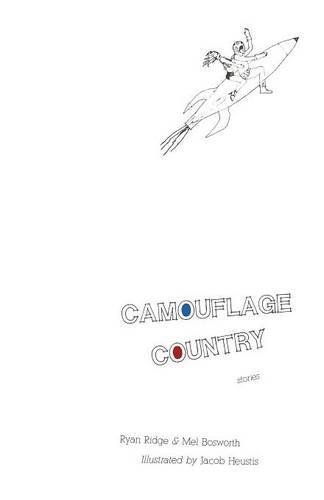Mel Bosworth caught the writing bug early. In fifth or sixth grade, he told his mother about an idea he had for a newspaper column and she immediately brought him down to the newspaper’s office to pitch the column to the editor. He spent the following summer producing weekly pieces on movies, pets, and other things of interest to young readers.
“It was all downhill from there,” Bosworth jokes, but since those days, he’s authored numerous chapbooks, including “Every Laundromat in the World”, and a 2011 novel, “Freight”. His work has been published in numerous literary reviews and he’s the creator of the Small Press Book Review. He’s recently collaborated on a new collection of short-form called “Camouflage Country” with fellow writer Ryan Ridge and illustrator Jacob Heustis. I recently spoke with Bosworth, a western Massachusetts native residing in Easthampton, about his latest work.
“Camouflage Country” is a collection of wildly imaginative capsules of surrealist Americana. The short, punchy pieces within its pages are chaotic enough to be funny and tragic enough to be heartbreaking. Reading it manages to be both fun and unnerving, with each 200-word burst landing uncomfortably close to home. These brief excursions into inner space illuminate the day-to-day humanity that hangs in plain view, yet so often goes unnoticed. It sometimes takes a warped lens like “Camouflage Country” to reveal it. The pieces themselves defy categorization, at once poetry and prose.
“It’s like a hybrid genre,” Bosworth says. “A lot of people call it prosetry, like prose and poetry mushed together, or verse fiction, so it’s a good blend of both those categories of writing.”
Pencil illustrations by Heustis, deliberately crude study hall masterpieces, contribute to the sense of nostalgia and childhood lost that Bosworth and Ridge cultivate throughout the book. The characters we meet are outlandish, like the half-man half-octopus or blood-thirsty mutants, yet each situation seems oddly familiar. It’s a psychedelic tour of the modern American landscape unconstrained by the laws of physics. The writing style and subject matter feel decidedly modern. Bosworth credits a Twitter exchange with Ridge for its conception.
“I was on Twitter one night,” Bosworth says. “And I wrote, ‘One man’s eating a sandwich and another man’s eating a hamburger,’ and Ryan chimed in, ‘But the third man is the wild card.’ And I thought that was funny and clever. I sent Ryan a direct message and I said, ‘Hey man, that’s pretty good. Do you want to try to do some more of these?’ and he said ‘Hey sure, why not,’ and that’s actually how it started.”
The two started collaborating in the same manner as their Twitter exchanges. One would send an opening to a story, the other would reply with a closing and the opening to another; each exchange resulting in two finished pieces.
“It was a blast,” Bosworth says. “People are like, ‘Which ones did you write and which ones did Ryan write?’ The duty was split right down the middle and you never would’ve guessed that.”
The game-like process, he says, was liberating. It left them free to try anything and discard or recycle the bits that just didn’t work. With time, Bosworth says, the form began to emerge.
“A lot of writing is just garbage, Bosworth says. “It’s just making a big pile of garbage, pulling pieces out of that garbage and making something else … When you actually build something good, it’s pretty satisfying in a way.”
While Bosworth has been writing for most of his life, he says he’s driven primarily by his need to create. While writing feels natural to him, it’s only a vehicle. If it wasn’t writing, he says, it would be something else. The desire to understand the world, society, and himself through creation is at the heart of his process.
“I guess I’m fascinated with people,” Bosworth says. “I’m fascinated with what makes me run. It’s a good sort of a self-analysis. So you’re kind of learning about yourself by telling these stories, whether they’re fiction or creative non-fiction. You’re telling stories to learn more about people and ultimately more about yourself.”
Accordingly, Bosworth says he doesn’t set out with any particular goals or vision in mind for most of his work, especially his short-form. It’s more about exploration and discovery. That spirit is embodied in “Camouflage Country” and, through it, the authors are able to convey life’s bittersweetness, to explore the difficult feelings that all of us grapple with at some point, whether we’re struggling to come to terms with a relationship that’s falling apart, to keep our family together, or to simply exist in a world which alternately deals us the greatest joys and deepest miseries. Bosworth and Ridge face it all with poignancy and humor.
“I guess ultimately what a lot of the writing is about is you’re just trying to build and represent believable emotions that people can relate to,” Bosworth says. “But you’re kind of shown glimpses of yourself in these fantastical situations and characters. So it’s almost like you’re tricked into being moved.”
By the time you put down “Camouflage Country”, though, you don’t feel tricked at all.•
— Peter Vancini, pvancini@valleyadvocate.com.



